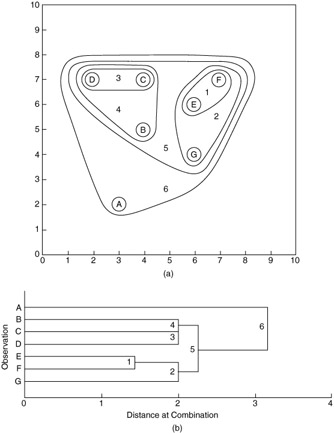FACTOR ANALYSIS
If you give a group of students 100 different aptitude tests, their scores on the different tests will no doubt be correlated. The tests probably measure some of the same characteristics, such as verbal skills, mathematical aptitude, reasoning ability, and perceptual speed. Characteristics such as "verbal skill," "mathematical aptitude ," and "reasoning ability" are not well-defined , easily measurable variables like weight or age. Instead they can be thought of as unifying concepts or labels that characterize responses to related groups of variables . A mathematically apt person would score well on all of the tests related to mathematical skills. In fact, that is how the definition of mathematical aptitude was formulated. Factor analysis is a statistical technique that attempts to measure such concepts.

Figure 9.12: Graphical portrayals of the hierarchical clustering process ” (a) nested groupings, (b) dendogram.
In some research situations, you have a set of interrelated variables such as consumer ratings of products. You think that the ratings are correlated because people are rating the products on similar dimensions such as product quality and utility. But you do not know what these underlying dimensions, or factors, are. You can use factor analysis to help you identify these underlying concepts by using a number of variables that you can directly measure.
EAN: 2147483647
Pages: 252